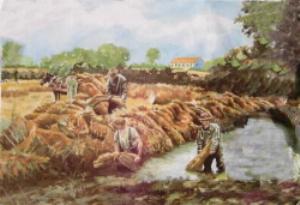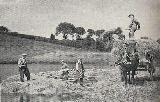|
|
|
| |
From Plant to Cloth. The production of linen begins with the plant flax,
this is a member of the grass family which produces a small brown seed,
when crushed it gives us linseed oil, used in the production of paint
and many other industrial products. It is the stalk The crop is grown in the same way as cereals, instead of being cut it is usually pulled, a crop that is cut produces shorter fibres, it is then threshed to remove the seeds. The stalks are then immersed and weighted down with stones in a lint hole or flax dam, this causes the unwanted parts of the stalk to decay, after a period of time in the lint hole the stalks are removed and dried, this process is said to be accompanied by some very unpleasant smells, this process is known as wretting. The wretted flax is then taken to a scutch mill, these were usually powered by water, sometimes by a turbine but mostly by a wheel, one such can be seen at the Ulster Folk and Transport Museum at Cultra County Down. In the scutch mill the stalks were first crushed between toothed rollers, they were then beaten by rotating wooden paddles similar to a fan, there would be a row, perhaps four of these beaters with an operators in front of each one. The beaters were all connected to a common shaft, and driven by the water wheel through a gear train to increase the speed. When the flax held against the beaters by the operator the outer unwanted parts of the stalk was removed leaving the fibres which then went to the spinning factory, to be spun into thread. It was advantageous to have the scutch mill in close proximity to where the crop was grown cutting down on transporting the bulky raw material. In the early days all linen thread was spun on a spinning wheel, eventually this process became industrialised. The spinning jennies as they came to be known spun the fibres into thread and wound it onto bobbins, these then went to the weaving factory. The Barbour Threads factory in Lisburn County Antrim was in its heyday the largest producer of linen thread in the world. According to Samuel Lewis' Directory of Co Londonderry an acre of land will produce 864 lbs (392 kg) of fibre. As with spinning weaving was once a thriving cottage industry, employing perhaps thousand of people. Many county towns such as Newtownards in County Down had streets of weavers houses especially built. In 1878 Bessbrook mill in County Armagh employed 1,500 out workers mainly in hand loom weaving, with a further 3,000 employed within the factory. The advent of the power loom largely put an end to home weaving, weavers who had previously worked from home and earned a reasonably good living, were driven of necessity to work in factories where long hours and poor pay were the norm. There were a few enlightened employers such as the Richardson's of Bessbrook who were Quakers. The linen industry in Ireland was probably at it's zenith between the late 1700's to the late 1800's. In 1712, 500,000 yards of completed linen cloth was exported by 1796 this had risen to 46,000,000 yards. By the early years of the 20th century the industry was under pressure the mid 1900's saw many factory's closing due mainly to increased production costs and competition from overseas. See also Water Power in Ireland and farm crops. |
||
|
|
|
|


 of the plant that supplies
the fibres from which linen thread is spun.
of the plant that supplies
the fibres from which linen thread is spun.